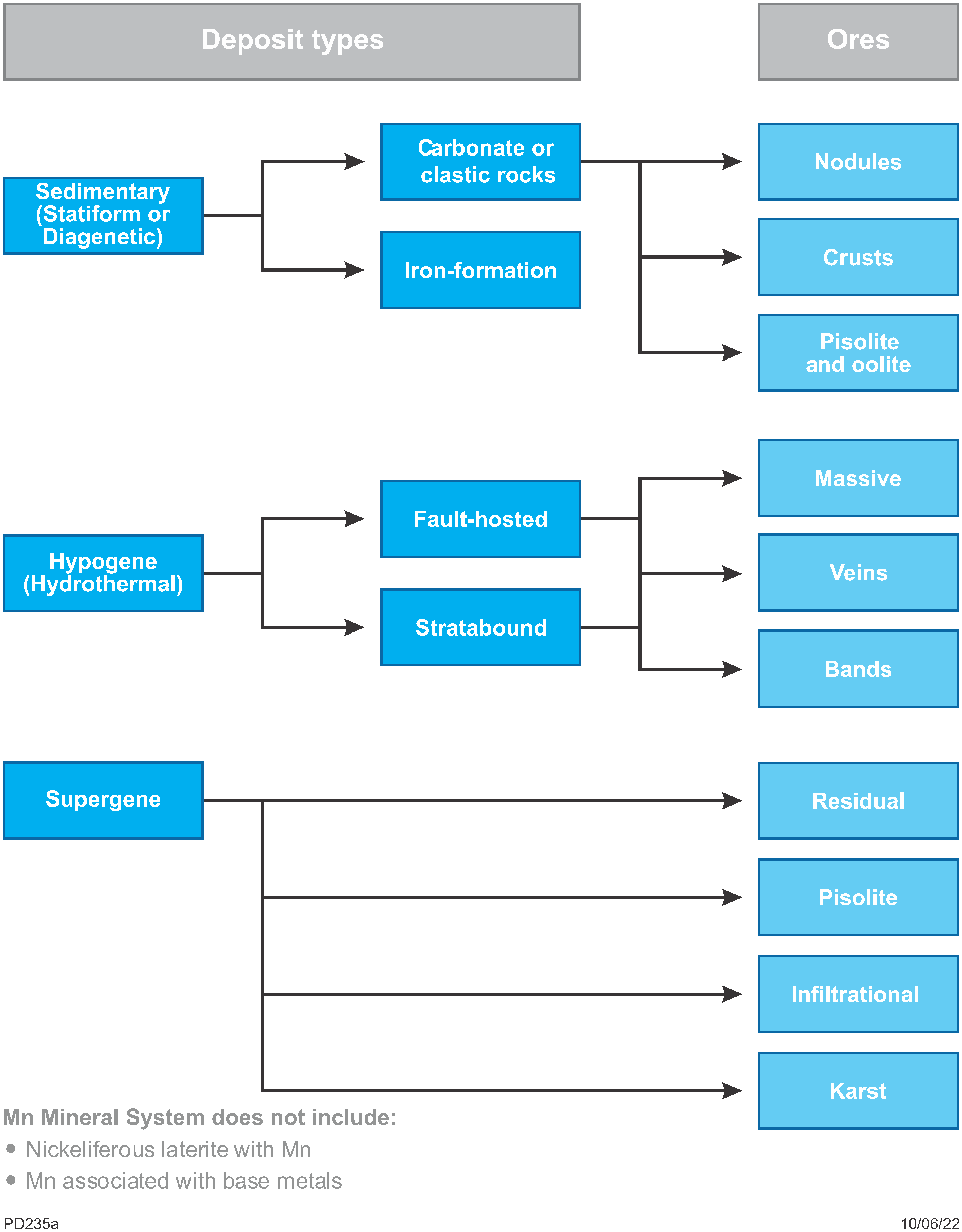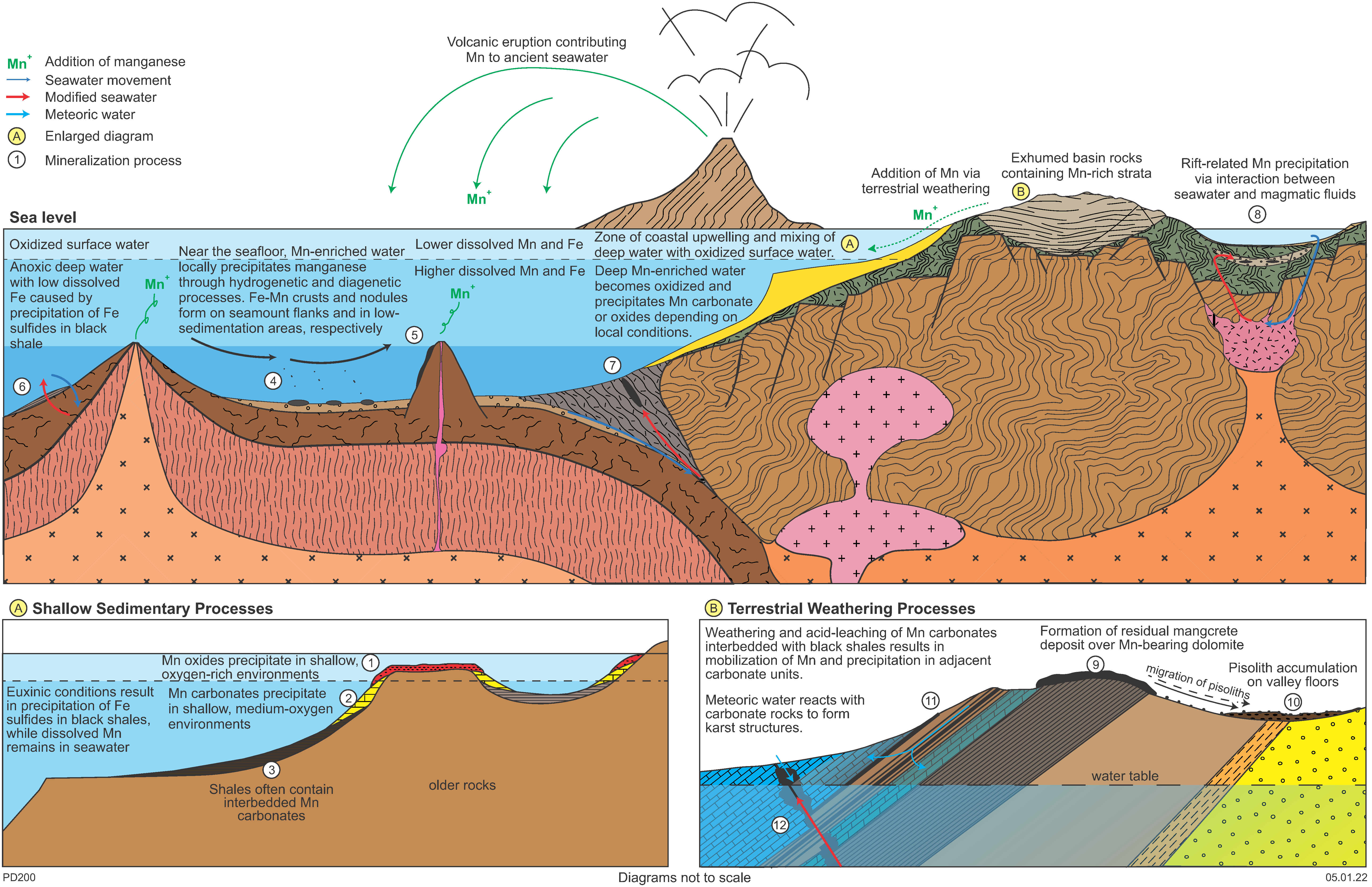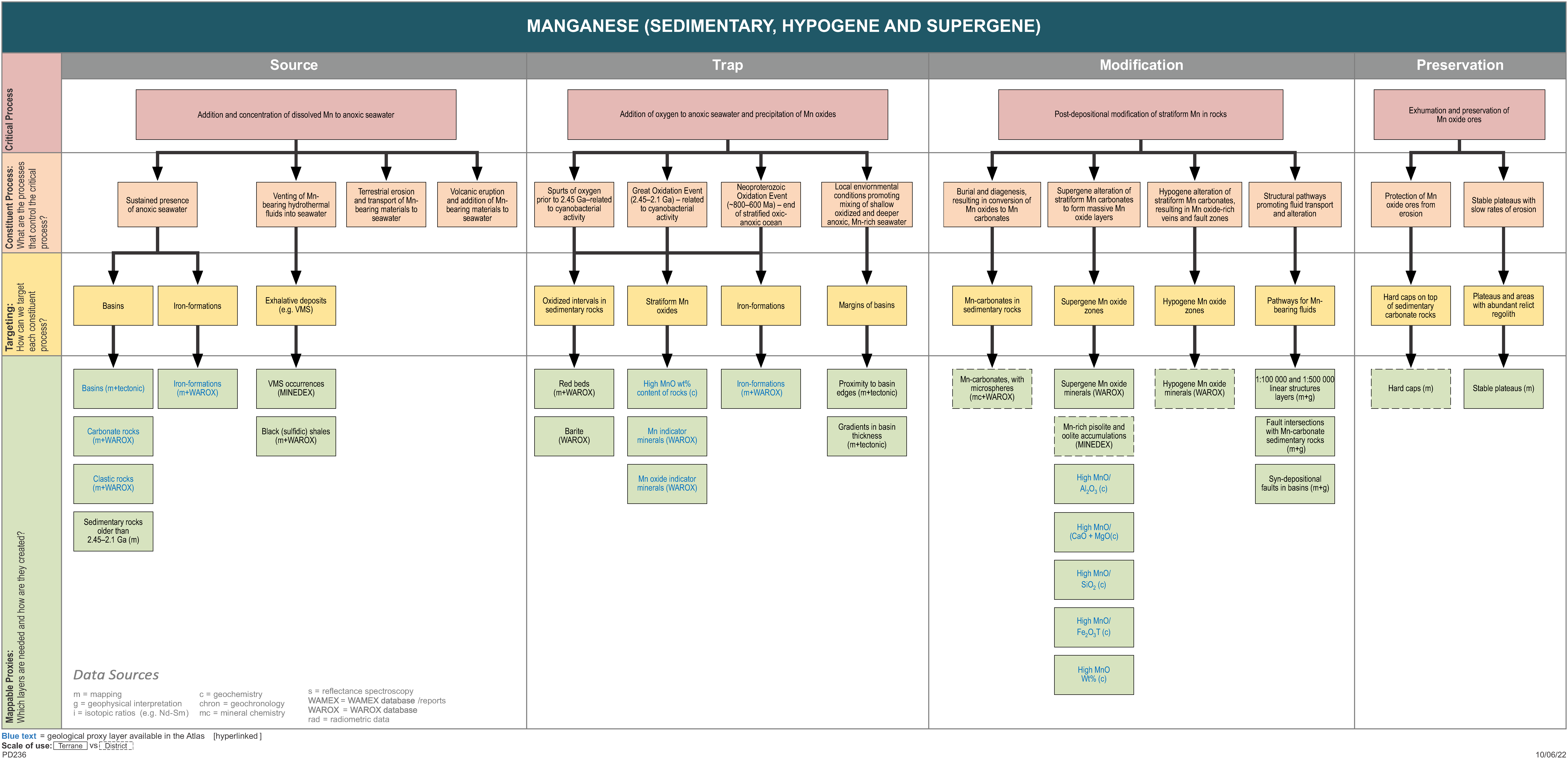Manganese is important to Australia’s critical minerals strategy. Manganese is used in a variety of industries, including in manufacture of renewable/dry cell batteries, wind turbines and aluminium steel alloys. Western Australia has produced about 14.8 Mt of Mn ore since 1948 (GSWA, 2021) and hosts several large Mn projects at various stages of development, including Butcherbird (26.13 Mt of contained Mn, calculated with an average ore grade of 10%), Woodie Woodie (15.00 Mt, 31% Mn), Oakover (6.42 Mt, 10% Mn), Nicholas Downs (2.09 Mt, 24% Mn), Balfour South (4.19 Mt, 19% Mn), South Woodie Woodie (1.90 Mt, 13% Mn), Flanagan Bore (1.70 Mt, 11% Mn) and Ant Hill – Sunday Hill (1.67 Mt, 21% Mn) (GSWA, 2021).
Classification of manganese deposits
Existing classification schemes of global Mn mineralization occurrences (e.g. National Materials Advisory Board, 1981; Roy, 1997; Kuleshov and Maynard, 2017; Cannon et al., 2017) divide Mn deposits into three main classes: Sedimentary (also called Sedimentary/Diagenetic or Stratiform), Supergene and Hydrothermal. This present study proposes the Mn mineral system that includes the three main deposit classes: Stratiform, Supergene and Hydrothermal (here called Hypogene). These deposit classes display strong spatial correlation and similar genetic controls. Figure 1 shows the parent–child relationships between the deposit classes and their potential ore types.
Stratiform deposits are the most common and the best understood of the Mn deposit classes. Stratiform deposits formed after about 3 Ga (Roy, 1997; Kuleshov and Maynard, 2017) and are in basinal settings: including marginal basins, subduction related trenches, back-arc basins, island arcs, small interarc basins and subduction-related shallow marginal basins (‘basin’ refers to a depressed area of the Earth’s crust in which sediments accumulate in substantial thickness; Bates and Jackson, 1987). The primary source of Mn in stratiform deposits is most likely the addition of manganese-bearing terrestrial sediments, undersea hydrothermal vents and volcanic ash to ancient seawater (Fig. 2). The redox-sensitivity of Mn, reduced seawater conditions and the reluctance of Mn to precipitate as sulfide minerals resulted in an increased concentration of dissolved Mn2+ (with Fe2+) in seawater. This process continued without disruption until significant oxygen was added to the atmosphere and hydrosphere due to biological outputs. Oxygen addition took place mainly after 3 Ga, and particularly during the Great Oxidation Event from ~2.45 to 2.1 Ga (Lyon et al., 2014); this led to the oxidation of dissolved Mn2+ and Fe2+ in seawater to precipitate Mn and Fe oxides. Stratification of oxygen concentrations in oceans during the Great Oxidation Event, and probably persisting until the Neoproterozoic Oxidation Event at c. 800–600 Ma, resulted in Mn oxide precipitation mainly occurring at the interface between (deeper) reduced seawater and (shallower) oxidized seawater. Consequently, basin margins were key sites for Mn oxide precipitation because of the rapid change in the slope of the sea floor and the greater likelihood for mixing between deeper and shallower waters. Marine transgressions increased the accommodation space and facilitated the development of large stratiform deposits on the edges of the continental shelves. Post-deposition, burial and diagenesis processes modified the composition and textures of stratiform deposits through the reduction of Mn4+ to Mn2+, and led to the redistribution of Mn in basinal sediments. Dissolved Mn reacted with sedimentary carbonates to form Mn carbonates and resulted in manganese-carbonate layers that are interlayered with clastic beds, such as black shales (Spinks et al., 2018).
Supergene Mn deposits commonly overlie stratiform occurrences. They form from the interaction of lower-grade stratiform Mn ores with near-surface, oxidized meteoric fluids. Higher-grade supergene ores result from dissolution of silicate minerals by meteoric fluids and concentration of less soluble Mn oxides. Supergene deposits display massive texture and vein ores. The best geological environments for supergene mineralization are those that have well-developed lateritic weathering crusts, such as those preserved in parts of Africa, South America, Australia, India and China (Kuleshov and Maynard, 2017).
Hypogene Mn deposits, also known as ‘hydrothermal’ or more specifically as ‘vein and hydrothermal’, occur as narrow, steeply dipping, fault-hosted or veined Mn ores in unweathered rocks and as stratabound zones adjacent to or above the fault-hosted Mn ores. Higher-temperature Mn oxide species, such as braunite, are more common in hypogene ores. Supergene overprint may increase ore reserves and ore grades (e.g. the ~50 m-thick, near-surface ore zones overlying the deeper extensions of the Woodie Woodie deposit in Western Australia; Jones et al., 2013, 2017), although notable standalone exceptions include the Orthris deposit in Greece (Robertson and Varnavas, 1993) and Burmister in Arizona (Hewett et al., 1963). The hypogene Mn deposits display similar controls to volcanic related hydrothermal vent systems, such as volcanic-hosted massive sulfides (VMS). Hypogene Mn deposits occur in mid-ocean ridge and subduction zone settings, including back-arc basins, small inter-arc basins, fore-arc terraces, as well as their shallow marginal basins and trenches adjacent to continental plate margins (Bonatti et al., 1976; Glasby, 1988; Roy, 1997; Maghfouri et al., 2017). In these areas, shallow magmatism most likely drives convection of seawater through the crust. Manganese is scavenged from rocks and transported in solution by hot, reduced, modified seawater. Fluids released at vent sites interact with surrounding cooler seawater and trigger the precipitation of Mn oxides and precious metals (Hein et al., 2000).
Nickeliferous Mn laterite and Mn associated with base metals are excluded from the Mn mineral system because they do not share strong genetic links with sedimentary depositional processes.
Figure 2. The schematic cross-sections summarize the main physical and chemical processes controlling Mn enrichment in rocks (modified after Kuleshov, 2011). Dissolved Mn in deep, anoxic ancient seawater is sourced from a variety of processes, including from volcanism, deep water hydrothermal venting or continental weathering and erosion. Cross-sections (A) and (B) are enlarged portions of the main sketch, demonstrating local environment influences on the precipitation of Mn. Details of specific processes are labelled numerically, with notes provided on the figure.
Critical processes
The Mn mineral systems model proposed here incorporates the stratiform, supergene and hypogene deposit classes (Fig. 1). These Mn deposit classes share the same critical processes: (i) the source of Mn is the addition and concentration of dissolved Mn2+ in ancient anoxic seawater, (ii) the subsequent addition of oxygen from biological outputs to anoxic seawater that triggers precipitation of Mn oxides, (iii) post-depositional modification of stratiform Mn ores that result in enrichment of Mn in rocks to economic ore grades, and lastly (iv) the exhumation and preservation of these Mn oxide ores.
Mineral system analysis
The Mineral System Tree is the graphical display of a mineral system analysis showing the link between critical and constituent processes and their recommended targeting features and geographic information system layers.
References
Bates, RL and Jackson, JA 1987, Glossary of geology: American Geological Institute, Alexandria, Virginia, USA, 788p.
Bonatti, E, Zerbi, M, Kay, R and Rydell, H 1976, Metalliferous deposits from the Apennine ophiolites: Mesozoic equivalents of modern deposits from oceanic spreading centers: Geological Society of America Bulletin, v. 87, no. 1, p. 83–94, doi:10.1130/0016-7606(1976)87<83:MDFTAO>2.0.CO;2.
Cannon, WF, Kimball, BE and Corathers, LA 2017, Manganese: United States Geological Survey, Reston, VA, Professional Paper 1802L, 40p., doi:10.3133/pp1802L.
Geological Survey of Western Australia (GSWA) 2021, Manganese: Investment opportunities, Western Australia: Geological Survey of Western Australia.
Glasby, G 1988, Hydrothermal manganese deposits in island arcs and related to subduction processes: A possible model for genesis: Ore Geology Reviews, v. 4, no. 1, p. 145–153, doi:10.1016/0169-1368(88)90010-8.
Hein, JR, Stamatakis, M and Dowling, JS 2000, Trace metal-rich Quaternary hydrothermal manganese oxide and barite deposit, Milos Island, Greece: Applied Earth Science, v. 109, no. 2, p. 67–76, doi:10.1179/aes.2000.109.2.67.
Hewett, DF, Fleischer, M and Conklin, N 1963, Deposits of the manganese oxides; supplement: Economic Geology, v. 58, no. 1, p. 1–51, doi:10.2113/gsecongeo.58.1.1.
Jones, S, McNaughton, NJ and Grguric, B 2013, Structural controls and timing of fault-hosted manganese at Woodie Woodie, East Pilbara, Western Australia: Ore Geology Reviews, v. 50, p. 52–82, doi:10.1016/j.oregeorev.2012.10.002.
Jones, SA 2017, Geology and geochemistry of fault-hosted hydrothermal and sedimentary manganese deposits in the Oakover Basin, east Pilbara, Western Australia: Australian Journal of Earth Sciences, v. 64, p. 63–102.
Kuleshov, VN 2011, Manganese deposits: Communication 1. Genetic models of manganese ore formation: Lithology and Mineral Resources, v. 46, no. 5, p. 473, doi:10.1134/S0024490211050038
Kuleshov, V and Maynard, JB 2017, Isotope geochemistry: The origin and formation of manganese rocks and ores: Elsevier, US, 392p.
Lyons, TW, Reinhard, CT and Planavsky, NJ 2014, The rise of oxygen in Earth’s early ocean and atmosphere: Nature, v. 506, p. 307-315.
Maghfouri, S, Rastad, E, Mousivand, F, Choulet, F and Ye, L 2017, Geological and geochemical constraints on the Cheshmeh-Frezi volcanogenic stratiform manganese deposit, southwest Sabzevar basin, Iran: Ore Geology Reviews, v. 89, p. 96–113, doi:10.1016/j.oregeorev.2017.06.015.
National Materials Advisory Board 1981, Manganese reserves and resources of the world and their industrial implications: The National Academies Press, Washington, DC, doi:10.17226/19671.
Robertson, A and Varnavas, S 1993, The origin of hydrothermal metalliferous sediments associated with the early Mesozoic Othris and Pindos ophiolites, mainland Greece: Sedimentary Geology, v. 83, no. 1, p. 87–113, doi:10.1016/0037-0738(93)90184-7.
Roy, S 1997, Genetic diversity of manganese deposition in the terrestrial geological record: Geological Society, London, Special Publications, v. 119, no. 1, p. 5, doi:10.1144/GSL.SP.1997.119.01.02.
Spinks, S, Thorne, R, Sperling, EA, White, AJR, Armstrong, JT, Brant, F, LeGras, M, Birchall, R and Munday, TJ 2018, Sedimentary manganese as precursors to the supergene manganese deposits of the Collier Group; Capricorn Orogen, Western Australia: CSIRO, Perth, Australia, 36p.



 Mineral System Tree: Manganese
Mineral System Tree: Manganese